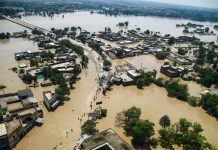The Bangladesh flood of 2022 and other climate-related events have a devastating impact on mental health outcomes in terms of depression and anxiety in Bangladesh
Bangladesh is the world’s seventh most vulnerable country to climate change, so extreme heat, humidity and flooding are, unfortunately, not uncommon.
Scientists at Georgetown University and colleagues at George Washington University and the World Bank in Bangladesh have studied the relationship between extreme environmental events, such as the Bangladesh flood in 2022, and mental health. The results have been published in Lancet Planetary Health.
What was the Bangladesh flood in 2022?
“Beginning in May 2022, deadly floods hit northeastern India and Bangladesh. Over 9 million people in both countries have been affected, and around 300 people have been killed. As of 22 June 2022, millions of people across the affected areas are reported to be in urgent need of food and medicine.
“In Bangladesh, floods from the Barak and Kushiyara rivers have mainly impacted the northeastern Sylhet and Sunamganj districts and as of 20 June have killed over 32 people. The floods have submerged over 53,000 hectares of agricultural land, damaging the crops. After the area was submerged in water, many fish could be seen floating from the flooded ponds and reservoirs.
“Due to the floods, the teaching activities of 640 educational institutions in Sylhet have been disrupted. In Sylhet district 55 unions were completely and 15 unions were partially flooded. On 22 May, it was reported that the flood situation in Sylhet had not changed much. There is a shortage of clean water in the flood-hit areas. Dams in different areas are weakened by severe floods. In June, at least 500 villages in different parts of Sylhet district were damaged and at least four lakh people were stranded. Power supply has been cut off in Sylhet and Sunamganj districts. As of June 18, the flood situation in the Sylhet region has further deteriorated.”
‘This should serve as a warning for other nations’
“We have now established a high-water mark that alas could soon be eclipsed for how climate can impact mental health in a highly vulnerable country. This should serve as a warning for other nations,” the study’s lead author Syed Shabab Wahid, DrPH, MPH, an assistant professor in the Department of Global Health at Georgetown University’s School of Health comments.
“Previous global research has found a link between these climate-related phenomena and adverse mental health outcomes regarding depression and anxiety. As climate change worsens, temperatures and humidity will continue to increase, as will natural disasters, such as extreme flooding, which portends worsening impact on our collective mental health, globally.”
Even small changes in weather can have catastrophic mental health outcomes
The researchers set out to measure climate-related variables at 43 weather stations in Bangladesh for changes in seasonal temperatures and humidity over two months.
They noted instances of exposure to flooding from study respondents. Admittedly, they said it would take years to monitor major climate change impacts. Still, their research does give a strong indication that even small changes in weather events linked to climate change can impact mental health outcomes.
In order to assess depression and anxiety in the adult population, the researchers conducted two sets of surveys, in both urban and rural areas, between August and September 2019 and January and February 2020. Over 7,000 people provided evaluable responses.
The researchers found that people experiencing one-degree Celsius higher temperatures during the two months preceding the study had:
- 21% higher probability of an anxiety disorder
- 24% higher likelihood of both depression and an anxiety disorder simultaneously
Similarly, one gram of moisture per cubic meter of air increase in humidity was found to create a six% higher probability of co-occurrence of anxiety and depression. However, no links between heat or humidity were identified with depression alone.
Exposure to worsening flooding linked to climate change in the region was attributed to increased odds of all conditions: depression by 31%, anxiety by 69% and the presence of both conditions by 87%. The overall prevalence of depression in the Bangladeshi population was 16.3%, which is considerably higher than global estimates of depression of 4.4% found in other studies.
In addition to the large disparity in depression levels in Bangladesh compared to global estimates, the research team found anxiety levels of 6.0% in Bangladesh compared to estimates of 3.6% globally.
What does the future hold for Bangladesh?
“Our next steps are two-fold. We want to develop and evaluate community-based interventions that are culturally appropriate for Bangladesh, such as offering mental health services to climate-affected communities, of which there are many throughout the country.
‘We also plan to conduct further research in Bangladesh and globally on the associations identified’
“We also plan to conduct further research in Bangladesh and globally on the associations identified in this study using longer-term approaches to narrow down the causes and effects of climate changes on mental health,” concludes Wahid.
Editor's Recommended Articles
-
Must Read >> Rohingya children: A ‘lost generation’ in Bangladesh
-
Must Read >> Floods devastate India, Bangladesh, and Nepal















